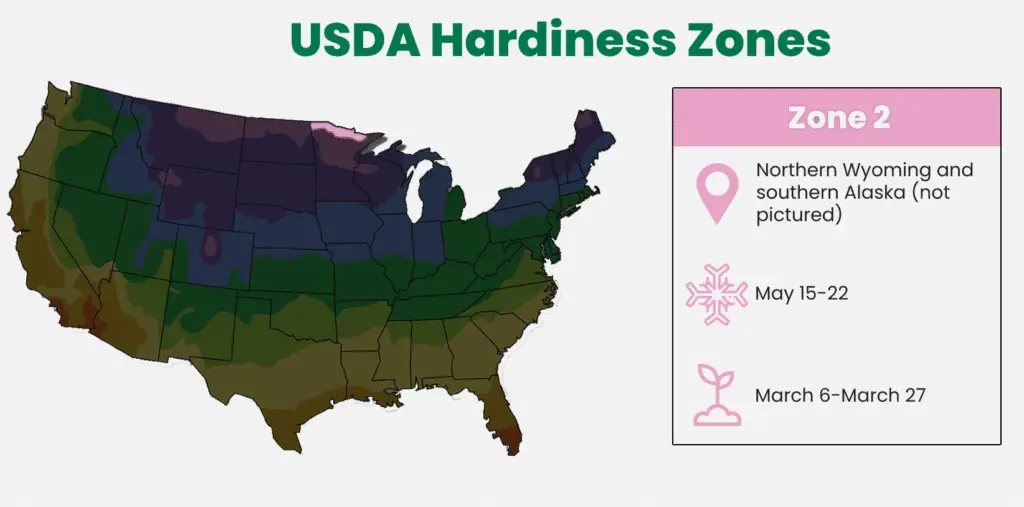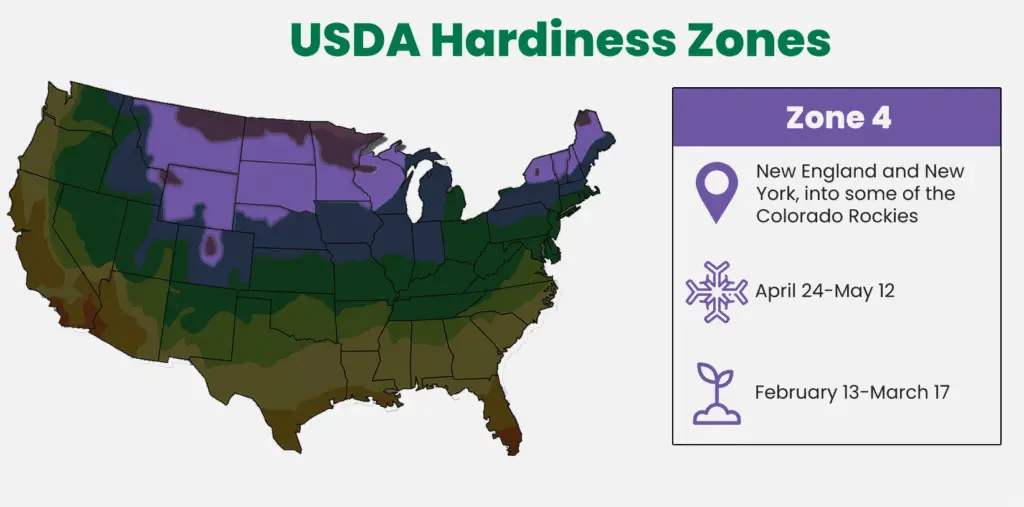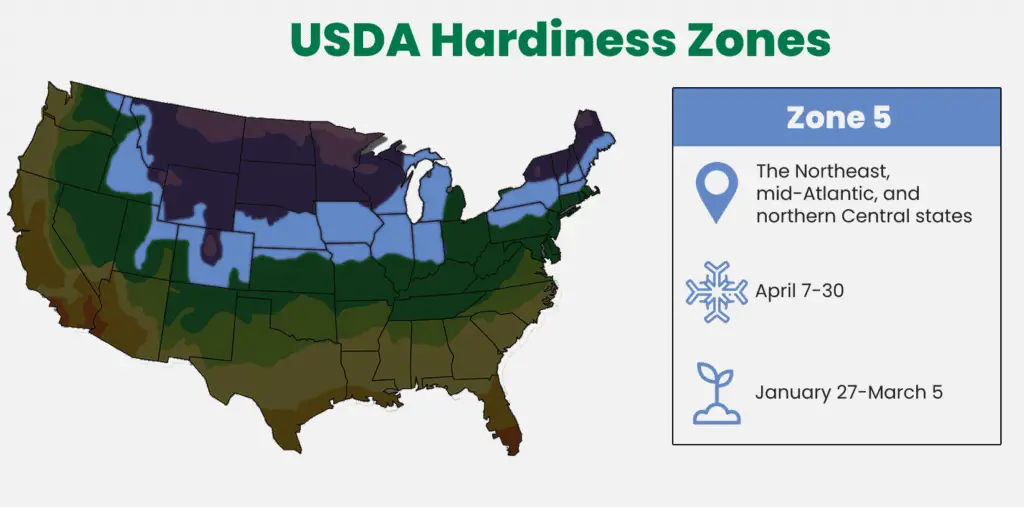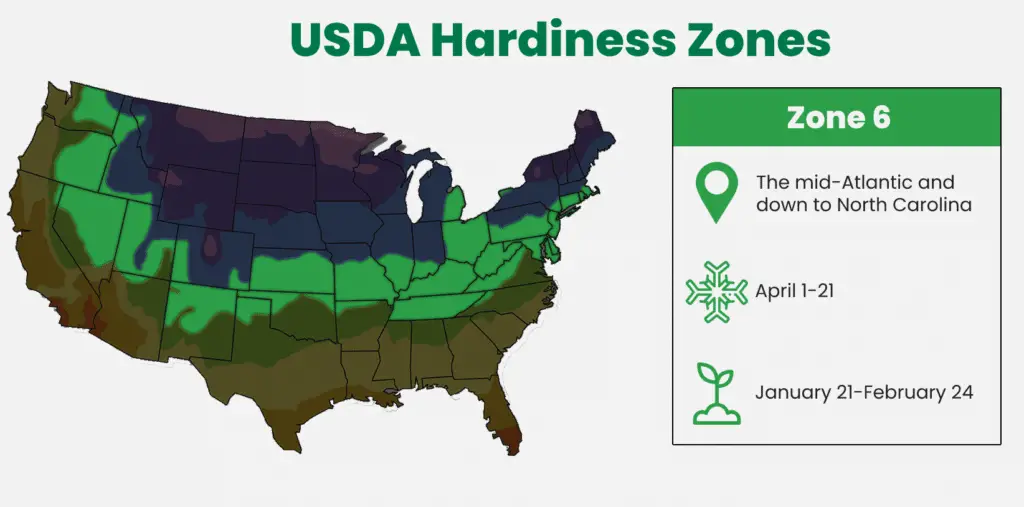To time your poblano pepper planting correctly, you need to utilize the USDA Hardiness Zone system.
Plant your poblano peppers according to what USDA Hardiness Zone you live in. For example, gardeners living in Zone 4 (New England) should start in February or March. Planting your poblanos at the right time will lead to healthy plants and high yields; planting outside of the recommended time means you will lose your pepper plants to cool weather.
Keep reading to learn about hardiness zones and the best time of year to plant poblanos in each.
Importance of planting poblano peppers at the right time
The difference that proper timing makes can’t be overstated!
It’s very important to plant poblano peppers at the right time. When you transplant your peppers, nighttime temperatures should be above 50°F and below 70°F. Proper planting leads to high yields and happy plants!
To demonstrate the importance of proper planting time, one study showed that corn yields can be improved or decreased by over 30% based on when you plant – even within just a 3-month window. You can view the chart here.
An important aim is for evening temperatures above 50°F upon transplant of your poblanos. Likewise, if nighttime temps reach above 70°F when you transplant, your peppers will be harmed.
Planting your poblanos at the right time will ensure that they have optimal growing conditions and the highest yields possible.
Explanation of the USDA Plant Hardiness Zones
Before we can go any further, it’s vital to know what exactly a USDA Hardiness Zone is.
USDA Plant Hardiness Zones inform gardeners of the best time to plant their crops, based on location. Zones are categorized per 10°F average minimum annual temperature. Different locations in the same Zone may require vastly different growing requirements due to the large span of the zones across the country.
USDA Plant Hardiness Zones help growers know what – and when – to plant based on where they live.
Hardiness zones were developed based on average minimum temperatures annually and are split into 10°F ranges.
The first attempt at a classification system was developed in the Arnold Arboretum using US Weather Bureau data and was widely used until 1990 when it was updated based on new weather information.
The USDA Plant Hardiness Zone map is helpful but still has its drawbacks. It doesn’t account for how long the minimum temperatures last, nor the microclimates that exist in each specific growing zone.
That being said, without scouring dozens of hyper-local gardening books, the Hardiness Zones are by far your best indicators of when to plant.
Map of growing zones in the US

Source: USDA
Although not pictured here, there are secondary zones in most areas. For the most detailed information about the best growing conditions for your area, consider researching your specific zone.
Regions where poblano peppers grow best
Poblano peppers require at least 6-8 hours of sunlight a day and warm temperatures. That means poblanos grow best in regions with these conditions.
Poblano peppers grow best in regions with a long growing season, lots of rain, and lots of sunshine. Even within the same USDA Zone, these factors may differ.
Since poblanos take 3-4 months from planting to the first harvest, gardeners with shorter growing seasons should start their seeds inside so the seedlings are ready to go in the ground after the first harvest.
Planting timing for poblano peppers by zone
Let’s get to know these zones a little bit better!
| Hardiness Zone | Last Frost Date | When to Plant Poblano Pepper Seeds in the ground |
|---|---|---|
| Zone 1 | May 22-June 4 | March 13-April 3 |
| Zone 2 | May 15-22 | March 6-March 27 |
| Zone 3 | May 1-16 | February 20-March 21 |
| Zone 4 | April 24-May 12 | February 13-March 17 |
| Zone 5 | April 7-30 | January 27-March 5 |
| Zone 6 | April 1-21 | January 21-February 24 |
| Zone 7 | March 22-April 3 | January 11-February 6 |
| Zone 8 | March 13-28 | January 2-January 31 |
| Zone 9 | February 6-28 | November 28-January 3 |
| Zone 10 | *no frost anticipated | *anytime |
Keep in mind that these planting dates are for seedlings that are started inside under growing lights. Poblano pepper seeds germinate best between 70-80°F, so you shouldn’t plan on starting them in the ground unless your region has an exceptionally long growing season.
Zone 1
Zone 1 is incredibly cold and very few plants grow naturally in the area.
Zone 1 encompasses some of the coldest places in the world, including the Yukon, Siberia, and northern Alaska. Plants grown in this region must be able to withstand temperatures of -50°F.
If you’re able to grow poblanos in this region at all, they will likely not be as good or healthy as in other regions because of the lower overall temperatures.
Regions in this area
Zone 1 is a very cold region including the Yukon, Siberia, and some of northern Alaska.
No part of the contiguous United States is considered Zone 1.
Optimal planting time
The best time to start poblano peppers in Zone 1 is between March 13 and April 3.
Special considerations
You’ll have a very short growing season in Zone 1 because of how long the winter lasts. Your best bet is to grow your poblano peppers in a greenhouse!
Zone 2

Regions in this area
Zone 2 regions include northern Wyoming and southern Alaska.
Optimal planting time
The best time to start poblano peppers in Zone 2 is between March 6 and March 27.
Special considerations
Just like Zone 1, Zone 2 has a short growing season and greenhouses are your best option.
Zone 3

Regions in this area
Zone 3 regions include northern Maine, Wisconsin, North Dakota, Minnesota, and Montana.
Optimal planting time
The best time to start poblano peppers in Zone 3 is between February 20 to March 21.
Special considerations
Zone 3 is still quite cold and greenhouses are your best friend!
Zone 4

Regions in this area
Zone 4 includes regions such as northern New England and New York, and even into some of the Colorado Rockies.
Optimal planting time
The best time to start poblano peppers in Zone 4 is between February 13 and March 17.
Special considerations
Poblano peppers growing in New England are in quite a different climate than in the Rockies, despite being in the same zone.
Zone 5

Regions in this area
Zone 5 includes regions in the Northeast, mid-Atlantic, and northern Central states.
Optimal planting time
The best time to start poblano peppers in Zone 5 is between January 27 to March 5.
Special considerations
Central states have a different climate than the Northeastern and mid-Atlantic states.
Zone 6

Regions in this area
Zone 6 includes regions in the mid-Atlantic and down to North Carolina.
Optimal planting time
The best time to start poblano peppers in Zone 6 is between January 21 and February 24.
Special considerations
Zone 6 is a great zone to grow poblano peppers, and most of the zone has a similar climate.
Zone 7

Regions in this area
Zone 7 regions include areas as north as Connecticut, as south as the Texas panhandle, and as west as Oregon.
Optimal planting time
The best time to start poblano peppers in Zone 7 is between January 11 and February 6.
Special considerations
Zone 7 is a large zone and climates vary greatly.
Zone 8

Regions in this area
Zone 8 regions include most of the Bible Belt and reaches the western coast into California.
Optimal planting time
The best time to start poblano peppers in Zone 8 is between January 2 and January 31
Special considerations
Just like Zone 7, Zone 8 spans across the country and growing conditions on the coast of California are quite different from those in the Bible Belt.
In fact, the conditions in the mountains of South Carolina and Georgia are very different from the coastal areas even within the same state.
Zone 9

Regions in this area
Zone 9 regions are quite warm and include the southeast, Texas, New Mexico, and Arizona, and even down to Hawaii.
Optimal planting time
The best time to start poblano peppers in Zone 9 is between November 28 and January 3.
Special considerations
Zone 9 has a long growing season and your biggest concern is heat – not frost!
Zone 10

Regions in this area
Zone 10 regions include the warmest temperatures: Hawaii, southern Florida, and southern California.
Optimal planting time
The best time to start poblano peppers in Zone 10 is whenever you want because there’s no frost!
Special considerations
Zone 10 is the hottest growing region, so the harsh sun and high temperatures are your biggest concerns.

